Leucodelphinidin
 | |
| Names | |
|---|---|
| IUPAC name
(2R,3S,4S)-2-(3,4,5-trihydroxyphenyl)-3,4-dihydro-2H-chromene-3,4,5,7-tetrol | |
| Other names
leukoefdin Leucoefdin leucodelfinidin Leucoephdine Leukoephdin | |
| Identifiers | |
| 12764-74-8 | |
| ChEBI | CHEBI:6417 |
| Jmol-3D images | Image |
| PubChem | 440835 |
| |
| Properties | |
| C15H14O8 | |
| Molar mass | 322.26 g/mol |
| Except where noted otherwise, data is given for materials in their standard state (at 25 °C (77 °F), 100 kPa) | |
| | |
| Infobox references | |
Leucodelphinidin is a colorless chemical compound related to leucoanthocyanidins. It can be found in Acacia auriculiformis,[1] in the bark of Karada (Cleistanthus collinus) and in the kino (gum) from Eucalyptus pilularis.[2]
Other species containing leucodelphinidin include Aesculus hippocastanum (Horse chestnut, in rind/bark/cortex), Arachis hypogaea (Earth nut in seeds), Arbutus unedo (Arbutus, in the leaf), Caesalpinia pulcherrima (Barbados pride), Ceratonia siliqua (Carob, in the fruit), Hamamelis virginiana (American witch hazel, in the leaf), Hippophae rhamnoides (Hippophae berry, in the leaf), Humulus lupulus (bine flower / blossom, in the leaf), Musa acuminata × balbisiana (Banana, in the fruit), Nelumbo nucifera (Baladi bean, in the leaf), Phyllanthus emblica (Emblic, Indian gooseberry, in the rind/bark/cortex), Quercus alba (White oak, in the rind/bark/cortex), Quercus robur (Common oak, in the rind/bark/cortex), Rumex hymenosepalus (Arizona dock, in the root), Schinus molle (California peppertree, in the leaf) and Vicia faba (bell-bean, in the seed).[3]
A leucodelphinidin derivative isolated from Ficus bengalensis shows hypoglycemic effects.[4]
Metabolism
Dihydroflavonol 4-reductase (DFR) uses dihydromyricetin (ampelopsin) NADPH and 2 H+ to produce leucodelphinidin and NADP.[5][6]
References
- ↑ A new flavan-3,4-diol from Acacia auriculiformis by paper ionophoresis, S. E. Drewes and D. G. Roux, 1966
- ↑ A study of leucoanthocyanidins of plants—I : Isomers of leucodelphinidin from karada bark and eucalyptus gum, A. K. Ganguly, T. R. Seshadri and P. Subramanian
- ↑ Leucodelphinidin on liberherbarum.com
- ↑ Hypoglycemic effects of leucodelphinidin derivative isolated from Ficus bengalensis (Linn). B S Geetha, B C Mathew, K T Augusti, 1994
- ↑ leucodelphinidin biosynthesis pathway proposed on biocyc.org
- ↑ Les cibles d’amélioration pour la qualité des raisins: L’exemple des flavonoïdes, Nancy Terrier (French)
| ||||||